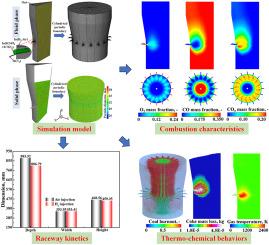喷氢对高炉滚道内煤-焦-气燃烧行为影响的数值研究
IF 4.3
2区 材料科学
Q2 ENGINEERING, CHEMICAL
引用次数: 0
摘要
本研究采用三维离散元模型-计算流体动力学-离散相模型(DEM-CFD-DPM)模拟了加氢对高炉滚道内燃烧特性、焦炭/煤/煤气热化学行为和动力学的影响。结果表明:H2的引入显著降低了滚道腔内O2浓度,提高了H2和H2O浓度;还原性气体(包括CO和H2)在风口尖端和出口的质量分数增加。由于H2和煤粉燃烧时的氧竞争,在H2注入下煤粉达到稳定燃尽值所需的时间延长。H2注入后,粒径较小的PC的燃尽量减小,而粒径较大的PC的燃尽量差异相对较小,与H2是否注入无关。此外,H2的注入不仅减少了焦炭的消耗,而且为回旋道提供了额外的热补偿。同时,H2的注入使滚道尺寸和焦炭动能略有减小。这些新发现为优化富氢注气和发展低碳炼铁技术提供了理论见解。本文章由计算机程序翻译,如有差异,请以英文原文为准。

Effects of hydrogen injection on combustion behaviors of coal-coke-gas in a blast furnace raceway: A numerical study
This study utilizes a three-dimensional Discrete Element Model-Computational Fluid Dynamics-Discrete Phase Model (DEM-CFD-DPM) to simulate the effects of hydrogen (H2) injection on the combustion characteristics, coke/coal/gas thermo-chemical behaviors, and kinetics in a blast furnace (BF) raceway. The results indicate that the introduction of H2 significantly reduces O2 concentration and increases H2 and H2O concentrations in the raceway cavity. The mass fractions of reducing gas (including CO and H2) at the tuyere tip and outlet increase. Due to the oxygen competition between H2 and PC combustion, the time required for pulverized coal (PC) to reach a stable value of burnout is extended under H2 injection. The burnout of PC with smaller particle size becomes a bit smaller when H2 is injected, while the difference in burnout for PC with larger size is relatively smaller regardless of whether H2 is injected. Additionally, the injection of H2 not only reduces coke consumption but also provides additional thermal compensation for the raceway. Meanwhile, H2 injection slightly reduces the raceway size and coke kinetic energies. These new findings provide theoretical insights for optimizing hydrogen-rich gas injection and the development of low-carbon ironmaking technology.
求助全文
通过发布文献求助,成功后即可免费获取论文全文。
去求助
来源期刊

Particuology
工程技术-材料科学:综合
CiteScore
6.70
自引率
2.90%
发文量
1730
审稿时长
32 days
期刊介绍:
The word ‘particuology’ was coined to parallel the discipline for the science and technology of particles.
Particuology is an interdisciplinary journal that publishes frontier research articles and critical reviews on the discovery, formulation and engineering of particulate materials, processes and systems. It especially welcomes contributions utilising advanced theoretical, modelling and measurement methods to enable the discovery and creation of new particulate materials, and the manufacturing of functional particulate-based products, such as sensors.
Papers are handled by Thematic Editors who oversee contributions from specific subject fields. These fields are classified into: Particle Synthesis and Modification; Particle Characterization and Measurement; Granular Systems and Bulk Solids Technology; Fluidization and Particle-Fluid Systems; Aerosols; and Applications of Particle Technology.
Key topics concerning the creation and processing of particulates include:
-Modelling and simulation of particle formation, collective behaviour of particles and systems for particle production over a broad spectrum of length scales
-Mining of experimental data for particle synthesis and surface properties to facilitate the creation of new materials and processes
-Particle design and preparation including controlled response and sensing functionalities in formation, delivery systems and biological systems, etc.
-Experimental and computational methods for visualization and analysis of particulate system.
These topics are broadly relevant to the production of materials, pharmaceuticals and food, and to the conversion of energy resources to fuels and protection of the environment.
 求助内容:
求助内容: 应助结果提醒方式:
应助结果提醒方式:


